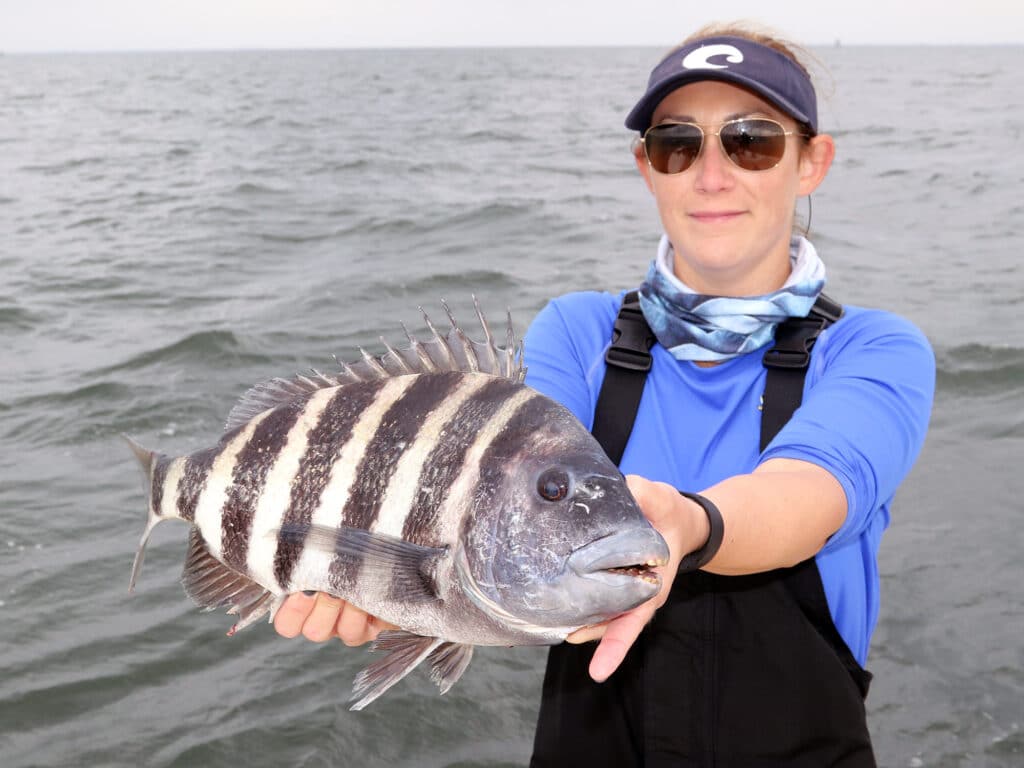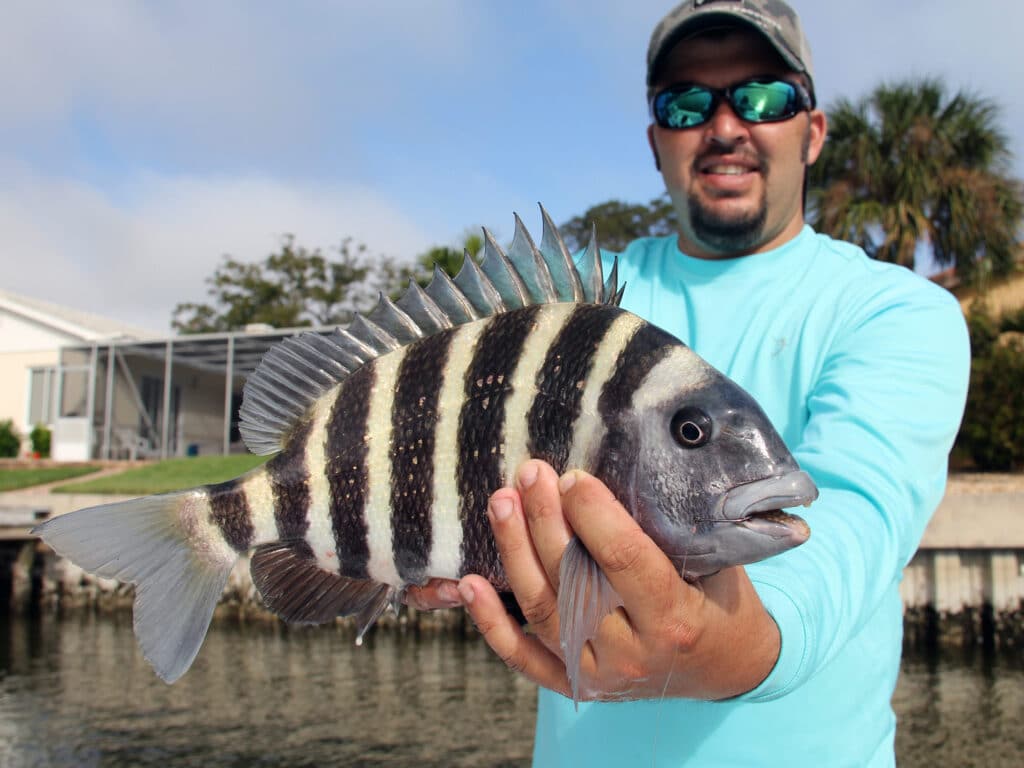
Hefty sheepshead, what some call “heads,” can be picky creatures. Once you understand what they’re looking for, you’ll quickly dial in the approach that leads to heavyweight opportunities. The right habitat and food sources make the magic happen. Luckily for anglers, the formula occurs with regularity.
Where to Find Sheepshead
Throughout their range, sheepshead (Archosargus probatocephalus) do a lot of their feeding around docks, piers, seawalls, bridges, rock piles, and reefs of natural or manmade origin. Basically, anywhere a hard surface provides growing opportunities for barnacles and hidey holes for crabs and marine invertebrates — that’s sheepshead country.
Take it one step further and find better quality fish in tucked-away, less-trafficked spots. This could be old docks in the back of a lengthy canal or winding bayou, a small rock pile or rubble reef off the beaten path, or one of the many limestone outcroppings peppered along Florida’s Big Bend region. Remember, if anyone can find it, everyone will fish it. Big sheepshead favor the more secluded stuff.
A tip from Tampa Bay sheepshead pro Capt. Chris Wiggins: “Find a large, older dock with lots of structure near a mangrove edge close to deep water,” he says. “That’s money.” Fortress-like habitat with food sources and depth for safety make prime sheepshead real estate.
Such spots produce throughout the year, but anglers fishing late fall through winter in the Gulf Coast fisheries will often find sheepshead gathering in spawning aggregations. This increases your likelihood of running into sizable sheepshead. Still, investing greater effort into finding out-of-the-way spots improves your chances of locating the bigger fish.
The Best Baits for Sheepshead

Every predator in the sea will eat a shrimp, and big sheepshead are no exception. But with prominent front teeth made for nibbling, these fish will pick a hook clean of the soft bait. Fresh shrimp often delivers good eating-size fish, but you have to get pretty lucky to nab a jumbo on this bait.
Locally collected oysters or mussels make a great option, as the tougher meat holds well to a hook. Also, use a hammer to crush the freshly shucked shells into a smelly grit, then toss handfuls into the target zone and watch the black-and-white forms dash through the intoxicating chum. Toss a piece of hooked shellfish into the fracas and hold on.
Without question, fiddler crabs top the sheepshead bait list. Don’t let the males’ oversized claw intimidate you; it’s more for territorial jousting and impressing the girls, so just fold that big pincher against the crab and you’ll be fine. Poke a 1/0 light-wire hook through the outermost point of the crab’s shell. You only need a secure holding spot, so don’t pierce the crab’s internal organs.
That Tricky Sheepshead Bite

The old saying, “You have to set the hook before a sheepshead bites,” accurately describe the challenge of snaring these notorious nibblers. Consider that the first bite seeks to crack shells or immobilize crustaceans, while the second means to ingest the meal.
Often, the game is over before it starts, as anglers see their rod tip bounce once and then nothing. Plan on donating a few baits, but once you dial in your rhythm it’s game on.
The right tackle and rigging greatly help your sheepshead fishing. Most sheepshead slayers use medium-heavy spinning gear with braided main line and a stealthy fluorocarbon leader, which provides quick response and fish-whipping power.
Rigging options include a knocker rig (slip sinker placed directly on the leader), split shot rig (for light current), or a standard fish finder. If the fish seen to shy away from terminal tackle, or if you’re fishing in excessively snag-prone areas like rock and rubble reefs, a light jig head brings the weight and hook into a smaller profile.
Fishing for Sheepshead in Current

Given the sheepshead’s nibbling ways, it’s easy to assume they’d prefer a slow to slack tide. In truth, they’ll eat throughout the cycle, but don’t discount periods of swifter flow. I once watched a dozen or more sheepshead repetitively rise to attack small tide-borne crabs drifting past pilings of Tampa Bay’s Sunshine Skyway Fishing Pier.
Anywhere you need to hold a bait during swift water movement, the usual sheepshead rigging may be hard to manage without risking snags. Take a page from the freshwater bass angler’s playbook and use a drop-shot rig. Tie your line to the hook with a Palomar knot and leave a long tag end, which you’ll pass through the hook eye. This makes the hook stand perpendicular to the line and allows you to hang a sinker from the tag line’s terminal end.
For simplicity, the VMC SpinShot offers a handy alternative by mounting a hook on a wire stem with line ties at both ends. Affix your main line to the top and then rig a fluorocarbon leader with a depth-appropriate weight to the bottom. This keeps your crab where it needs be, but elevation off the bottom minimizes snagging.
However you catch your sheepshead, handle with care. Those fins, especially the dorsal, are built with stout spines that’ll leave a memorable poke. On the other hand, the effort to find, hook and land these fish cab lead to a delicious meal. Often called “poor man’s lobster,” the sheepshead’s flaky white meat is one of the best you’ll find in coastal waters. Stay frosty and don’t miss that bite.








